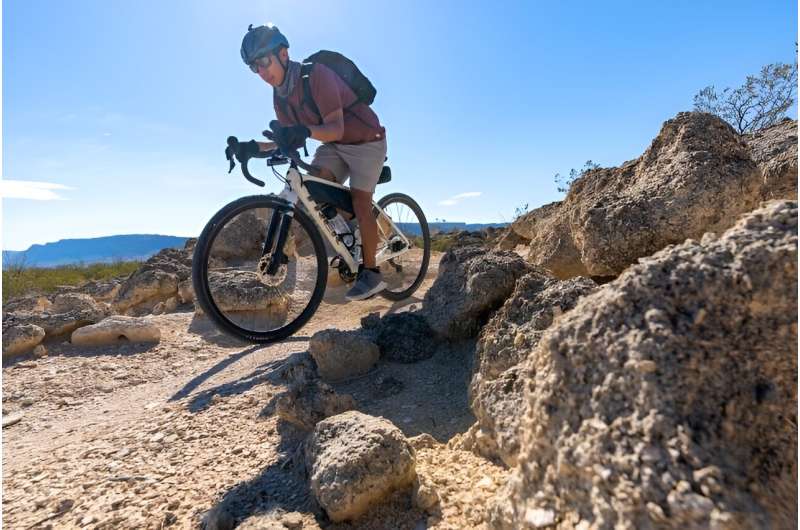This article has been reviewed according to Science X's editorial process and policies. Editors have highlighted the following attributes while ensuring the content's credibility:
fact-checked
peer-reviewed publication
trusted source
proofread
Exercise in natural settings may provide more benefits than indoor exercise

Health practitioners and fitness buffs have long known that regular physical activity offers numerous health benefits, including the prevention of chronic conditions such as cardiovascular disease, diabetes, some cancers and osteoporosis.
In addition, exercise enhances immune function and pain control, reduces fall risk and extends life expectancy. Mental health benefits include improved mood, reduced anxiety and decreased risk of dementia and depression.
Despite all these benefits, more than three out of four adults in the United States get far less exercise than the recommended 150 to 300 minutes a week of moderate physical activity or 75 to 150 minutes a week of vigorous physical activity.
Studies have also found that outdoor places such as parks and trails are effective settings for physical activity. The COVID-19 pandemic made this especially clear. Moreover, being in nature provides physical and mental health benefits similar to those of physical activity.
To date, little has been known about any potential additive benefits of engaging in physical activity in natural settings. Could being outdoors increase the effects of exercise while also encouraging more people to exercise? And if so, how could health professionals promote this behavior?
To answer these questions and more, Jay Maddock, Regents Professor with the School of Public Health at Texas A&M University and director of the university-led, collaborative Center for Health & Nature, along with Howard Frumkin, Hagler Fellow and senior vice president and director of the Land and People Lab, assessed the current scientific evidence regarding physical activity in natural settings and developed strategies for promoting these activities.
Their study, published in the American Journal of Lifestyle Medicine, identified several factors that affect how often people visit parks and natural settings, the extent to which they engage in physical activities once there and the benefits they get from this activity.
Maddock and Frumkin found that research suggests exercising in a park or other natural setting is more beneficial than exercising indoors. These studies focused on short-term outcomes of less than one year, however, and whether these benefits occur over the long term remains to be seen.
"Despite this, the research is clear that natural settings could be an effective venue for promoting physical activity," Maddock said. "People generally enjoy being outdoors, with parks, trails and community gardens being the most popular venues."
Factors that make these venues more attractive to visitors include physical features such as community centers, playgrounds, lighting and clear signage, as well natural features such as tree canopy and bodies of water that are well maintained. Activities such as classes and festivals also contribute to their popularity, as do a welcoming environment, a perception of safety, and visitors' strong feeling of connectedness to nature and belief that spending time in these spaces is important.
"Parks and trails are particularly important due to their accessibility and widespread availability, but access varies significantly by geography, and rural areas often have less access to natural spaces because they have more privately held land," Maddock said. "For example, nearly 98 percent of Illinois residents live within half a mile of a park, compared to only 29 percent in Mississippi."
Maddock and Frumkin also found that use of parks and greenspaces for physical activity varies across demographic groups, with men more likely than women to use these spaces for physical activity. In addition, a study of parks in Los Angeles found that Black adults are less likely than white adults to engage in physical activity in parks, while English-speaking Latinos are equally likely and Asian/Pacific Islanders are more likely.
"Some groups—Black, Indigenous, and other people of color and immigrant and refugee populations, for example—often have experienced historic or current discrimination that hinders their use of natural spaces, and they routinely have less access to high-quality parks," Frumkin said. "In addition, children, the elderly and people with disabilities face challenges in accessing natural spaces. Ensuring that these spaces are safe and easy to navigate, with appropriate programming, could help increase their use of parks and other natural settings."
With these complexities in mind, Maddock and Frumkin offer four options that health care professionals could implement to encourage the use of parks and other natural settings by their patients.
One is simply to "prescribe" nature contact to patients.
"Recommending that patients spend more time in these settings is known as nature prescriptions or 'ParkRx,' and while more research is needed, the studies to date suggest that this approach is effective," Maddock said.
Another is for health professionals to model this behavior by engaging in it themselves. This modeling has been found to be effective in promoting healthy behaviors while also enhancing the well-being of the health professionals.
A third approach is for health professionals to engage in community efforts that promote the use of outdoor spaces, such as Houston's Be Well Communities initiative, which is supported by the M.D. Anderson Cancer Center.
Finally, health professionals could help create and maintain parks and greenspaces by steering funds into these efforts through Community Health Needs Assessments, Medicaid funds and funds from health care conversion foundations.
"It is clear that the use of parks and natural settings for physical activities could be a potentially powerful tool for promoting two important health behaviors simultaneously," Maddock said. "This could be especially important given that the majority of Americans do not get enough exercise or spend enough time outdoors."
More information: Jay E. Maddock et al, Physical Activity in Natural Settings: An Opportunity for Lifestyle Medicine, American Journal of Lifestyle Medicine (2024). DOI: 10.1177/15598276241253211





















